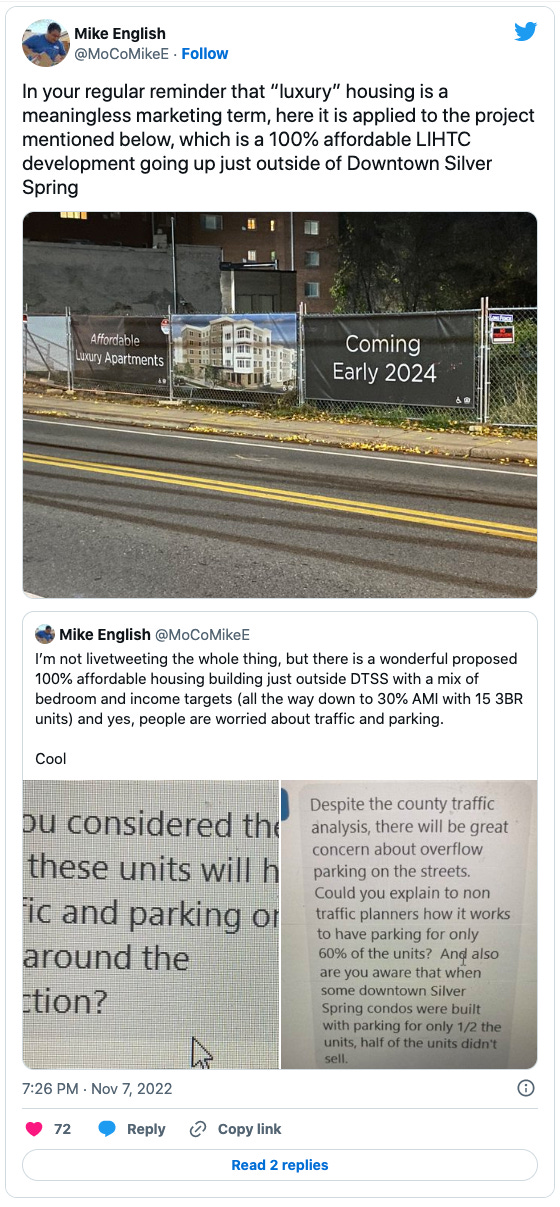AFFORDABILITY | Gold Toilets and Wrecking Balls
How "luxury" housing can help reduce rents and prevent homelessness.
Written By Luca Gattoni-Celli
Many question whether the housing affordability crisis in the US and other countries is really caused, at root, by a shortage of homes. This skepticism defies the observable reality of long waiting lines to view apartments in New York City and 300-plus people bookmarking a new home in DC-proximate Fairfax County, Virginia, only a day after it has been listed online (ask me how I know). Critics view YIMBYs and other housing supply advocates as either useful fools or rotten liars. So how can we possibly believe that market-rate (unsubsidized) housing or “luxury” apartments or condos make housing more affordable for even the poorest of the poor?
I could question the premise, since “luxury” as a real estate term appears to be pure marketing. The photo below speaks to that idea. Of course, new market-rate housing is inherently expensive relative to the equivalent home (e.g., in the same location) that is not new. But let us imagine a luxury condo building so opulent that it has gold toilets. Only the wealthiest of the wealthy could live there, sipping Acqua Panna and spelling the word crudités correctly without having to look it up. Adding such luxurious homes to the local housing stock would actually take pressure off the economic drivers of homelessness. Allow me to explain.

Ask yourself, where did the people now sitting on those golden thrones live before? Probably in less expensive homes, right? After all, we are talking about the nicest condos and apartments imaginable. One living room (obviously, there would be a few in each unit) has a fountain with those peeing boy statues. If Donald Trump is a poor person’s idea of a rich person, then the people living in our imaginary building are a rich person’s idea of a rich person.
Too much money is chasing too few homes. That demand is what is truly trickling down, squeezing the most socioeconomically vulnerable individuals and families—sometimes out onto the street.
To fully understand how our building would impact the housing market, we would have to add a final element to the thought experiment: Consider what would happen if we demolished our building. The gold toilets would be melted down for fixtures in a new structure, perhaps the world’s largest Hermès store. Our residents, assuming they chose to maintain a home in the same area, would move to less expensive homes. They would outbid or buy out marginally less wealthy residents. And the folks who were, in the most benign sense of the word, displaced would, in turn, move to marginally less exclusive homes and neighborhoods. This basic dynamic would continue to ripple through the local housing market. And in that way, a few more of the working poor might find they cannot quite keep up with this year’s rent increase.
The term “filtering” was coined to describe how even new high-end homes relieve pressure on the low-cost end of the housing market. Critics derisively call this “trickle-down housing policy,” but under the status quo, too much money is chasing too few homes. That demand is what is truly trickling down, squeezing the most socioeconomically vulnerable individuals and families—sometimes out onto the street.
I founded a grassroots pro-housing group called YIMBYs of Northern Virginia. The Tuesday before Thanksgiving of 2022, a member of my team and I were invited to tour a homeless shelter in Alexandria, the city where I live. The staff member who gave the tour was excited to meet us. She drew a direct connection between the systemically discriminatory zoning and land use rules our group is working to dismantle and the families her shelter helps get back onto their feet and into permanent and stable housing. She has seen a recent increase of folks experiencing homelessness in our area, not only because the COVID-19 eviction moratorium ended, but also because rents keep rising. And the shelter battles low vacancy rates to find new homes for its clients.
There is an unforgiving, all-too-real relationship between low apartment vacancy rates, high rents, and the crisis of homelessness in American cities. New homes with gold toilets will obviously not solve the problems in our housing market, but they would genuinely help. We must think big about ending the housing shortage and find ways to say yes to new housing in our backyard. Rejecting housing that does not fit a preconceived ideal is a luxury no one should be entitled to.
Luca Gattoni-Celli is a fast-learning urbanist and (social) entrepreneur. He founded YIMBYs of Northern Virginia (yimbysofnova.org) in 2021. He is a Catholic former federal tax reporter with an economics background.
This piece was initially posted on Medium.com on November 26, 2022.

